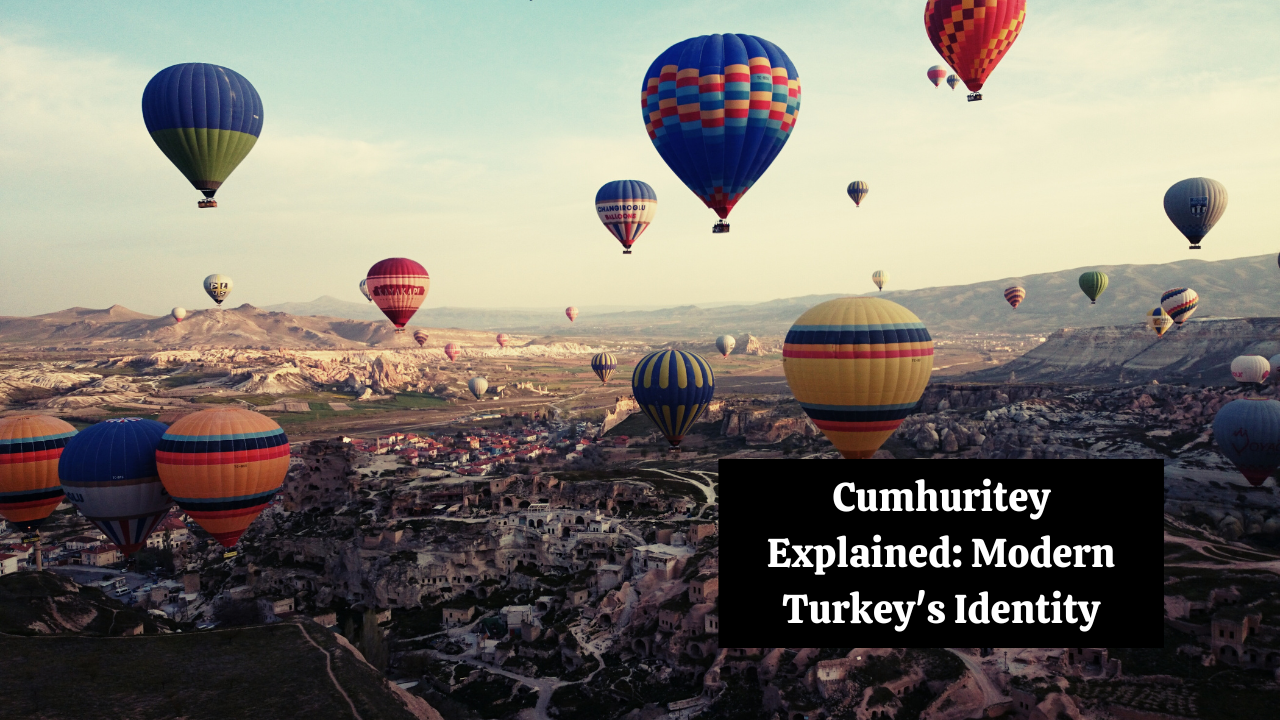Cumhuritey: Picture a phoenix, a mythical creature rising renewed from the flames. This powerful image resonates with the story of Turkey. Once the heart of the vast Ottoman Empire, a land stretching across continents and encompassing a multitude of cultures, the empire crumbled in the aftermath of World War I.
A Nation Redefined: Yet, from the ashes of the Ottoman Empire emerged a new nation – the Republic of Turkey. This dramatic transformation hinged on a single, powerful concept: Cumhuritey. Literally translating to “republic” in Turkish, Cumhuritey became more than just a word; it embodied the core principles that would define the future of Turkey.
Mustafa Kemal Atatürk: The Architect of a New Era: Enter Mustafa Kemal Atatürk, a visionary leader who rose from the ashes of the empire. Recognizing the need for a complete overhaul, Atatürk championed Cumhuritey as the cornerstone of a modern, secular Turkish identity.
Cumhuritey: The Key to Understanding Turkey: Understanding Cumhuritey, therefore, is akin to unlocking the soul of modern Turkey. Its principles – from secularism to nationalism – continue to shape the nation’s social fabric, political landscape, and even foreign policy. So, delve into this exploration of Cumhuritey, a concept as fascinating as the nation it defines.
The Pillars of Cumhuritey
The Bedrock: Secularism and the Separation of Mosque and State
Cumhuritey’s foundation rests firmly on the principle of secularism. This concept, often misunderstood, goes beyond mere freedom of religion. It signifies a clear separation of the state and religious institutions. The caliphate, the symbolic head of Islam once housed within the Ottoman Empire, was abolished. Religious courts were replaced with a secular legal system. Educational reforms emphasized a scientific and secular curriculum.
This emphasis on secularism aimed to forge a unified Turkish identity that transcended religious divisions. The vast Ottoman Empire encompassed a mosaic of faiths, from Islam and Christianity to Judaism. Cumhuritey sought to create a national identity based on shared citizenship, not religious affiliation. This approach aimed to foster national unity and prevent religious conflicts that had plagued the empire.
However, it’s important to acknowledge that Cumhuritey’s brand of secularism was, at times, authoritarian. While religious freedom existed, the state maintained control over religious institutions and practices. This approach continues to be debated in modern Turkey, with some advocating for a more relaxed interpretation of secularism.
The Guiding Light: Kemalism and its Six Arrows
Cumhuritey found its guiding light in the ideology of Mustafa Kemal Atatürk, aptly named Kemalism. This comprehensive set of principles acted as a roadmap for the nascent Republic of Turkey. At its core, Kemalism comprised six fundamental pillars:
-
Nationalism: A strong sense of Turkish national identity, emphasizing a shared history, language, and culture, replaced the multi-ethnic structure of the Ottoman Empire.
-
Republicanism: The abolishment of the Ottoman sultanate and the establishment of a democratic republic with popular sovereignty.
-
Populism: Emphasis on the power and will of the people, aiming to bridge the gap between the government and the citizenry.
-
Étatisme: A focus on state-led economic development, with the government playing a significant role in industrialization and infrastructure projects.
-
Secularism: As discussed earlier, the separation of religion and state to create a unified national identity.
-
Revolution: The unwavering commitment to transformational change, dismantling old institutions and traditions to pave the way for a modern Turkey.
These principles, collectively known as the “Six Arrows,” profoundly shaped the early years of Cumhuritey. A sweeping modernization program was launched, transforming everything from clothing styles to the legal code. Education became a priority, fostering a new generation of Turks imbued with Kemalist ideals. While some aspects of Kemalism remain contested, it undeniably laid the groundwork for the modern Turkish Republic.
Embracing the West: Modernization with a Double-Edged Sword
Cumhuritey’s architects envisioned a modern Turkey integrated with the West. This translated into a deliberate effort towards Westernization. Political structures borrowed heavily from European democracies, with a multi-party system and a focus on individual rights. Social reforms aimed to create a more secular society, with changes in dress codes, the adoption of the Latin alphabet, and the emphasis on women’s suffrage.
However, this Westernization drive wasn’t without its challenges. Critics argued that it led to a cultural disconnect, imposing Western values on a society with a rich Islamic heritage. Maintaining a unique Turkish identity while embracing Western advancements became a constant balancing act.
Despite the challenges, Westernization yielded undeniable successes. It facilitated Turkey’s economic growth and integration with the global market. Educational reforms fostered a generation of skilled professionals. The adoption of Western legal codes strengthened the foundations of a modern state.
In conclusion, Westernization served as a double-edged sword for Cumhuritey. It facilitated progress but also sparked debates about cultural preservation. This complex dance with the West continues to shape Turkey’s trajectory in the 21st century.
Forging Unity: Turkish Nationalism and its Complexities with Cumhuritey
Cumhuritey embraced a robust form of Turkish nationalism, aiming to forge a unified nation from the ashes of the diverse Ottoman Empire. This ideology emphasized a shared Turkish history, stretching back to Central Asia and encompassing the Ottoman legacy. The Turkish language became a national symbol, with language reforms promoting its widespread use. Cultural practices and traditions were highlighted to foster a sense of collective identity.
This emphasis on shared heritage unquestionably fostered national unity, particularly after the trauma of World War I. It gave rise to a strong sense of Turkish patriotism and a commitment to the newly formed republic.
However, the narrative of Turkish nationalism under Cumhuritey is not without its critics. Concerns have been raised about its inclusivity, particularly regarding minority groups like Kurds, Armenians, and Greeks. The focus on a singular Turkish ethnicity can be seen as marginalizing these communities.
This debate continues to this day. Some advocate for a more nuanced understanding of Turkish identity, one that acknowledges the nation’s rich ethnic tapestry. Finding a balance between national unity and acknowledging diverse identities remains a challenge for Cumhuritey in the modern era.
Cumhuritey Today: Navigating a Shifting Landscape
The Evolving Landscape: Debates and Challenges
Cumhuritey, though a cornerstone of modern Turkey, faces ongoing debates and challenges. The role of Islam in society remains a contentious issue. While Turkey is a secular state, Islam plays a significant role in the lives of many citizens. Finding a balance between religious freedom and upholding secular principles is a constant negotiation.
Freedom of expression also presents a complex issue. Cumhuritey’s emphasis on national unity can sometimes clash with individual liberties. Debates arise regarding criticism of the government and the treatment of dissenting voices.
The rights of minorities continue to be a point of discussion. While strides have been made, some minority groups feel their cultural identities are not fully recognized within the framework of Cumhuritey’s national narrative.
Enduring Legacy: A Modern Nation Forged
Despite these challenges, the core principles of Cumhuritey continue to shape Turkish identity and foreign policy. The emphasis on a modern, secular nation-state remains a defining characteristic. Republicanism and democracy, pillars of Cumhuritey, continue to guide Turkey’s political system.
Cumhuritey’s legacy is undeniable. It transformed a crumbling empire into a modern nation-state with a unique identity. While navigating the complexities of the 21st century, Cumhuritey’s core principles remain the foundation for a strong and independent Turkey.
Conclusion: Cumhuritey’s Enduring Journey
A Legacy Unfurled: Recap of Cumhuritey’s Significance
Cumhuritey, meaning “republic” in Turkish, transcends a mere word. It represents the very foundation of modern Turkey’s identity. Emerging from the ashes of the Ottoman Empire, Cumhuritey championed secularism, nationalism, and Western-inspired reforms, forging a unified nation from a diverse population.
This concept served as a guiding light for the early Turkish Republic, shaping its political structure, social fabric, and foreign policy. It fostered national unity and facilitated progress, propelling Turkey into the modern era.
Cumhuritey in the 21st Century: An Evolving Narrative
However, Cumhuritey is not a static concept. In the 21st century, Turkey grapples with reconciling the core principles of Cumhuritey with the realities of a globalized world. Debates around religious expression, minority rights, and freedom of speech continue. Finding the right balance is a constant challenge.
Looking Forward: A Thought-Provoking Question
As Turkey navigates the complexities of the modern world, one question arises: How will Cumhuritey adapt and evolve in the face of globalization and Turkey’s growing role on the international stage? Will it continue to be the bedrock of Turkish identity, or will it need to adjust to accommodate a changing world order?
Call to Action: Delve Deeper
This exploration of Cumhuritey is merely a starting point. We invite you to delve deeper into the rich tapestry of Turkish history and culture. Learn more about the fascinating journey of the Republic of Turkey, and engage in respectful discussions about Cumhuritey’s enduring impact. The story of Cumhuritey continues to unfold, and your exploration can be part of its ongoing narrative.





